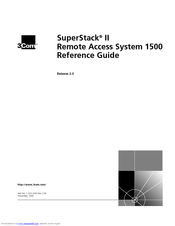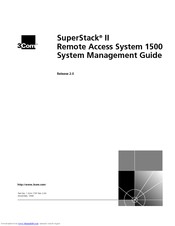3Com 3C421600A Remote Access Server Manuals
Manuals and User Guides for 3Com 3C421600A Remote Access Server. We have 5 3Com 3C421600A Remote Access Server manuals available for free PDF download: Management Manual, Reference Manual, Quick Setup Manual, Release Note, Installation Manual
3Com 3C421600A Reference Manual (269 pages)
SuperStack II Remote Access System
Brand: 3Com
|
Category: Network Hardware
|
Size: 2 MB
Table of Contents
-
About
19 -
-
-
User Table25
-
Module Table26
-
SYSLOG Table27
-
File Table27
-
Modem Tables28
-
PPP Tables29
-
-
-
-
Show Memory43
-
-
-
Add Commands57
-
Add Bridge58
-
Address66
-
Address76
-
Arp Command77
-
Address77
-
Bye Command79
-
Bye79
-
-
Copy Command79
-
-
Network Name79
-
Zone Name79
-
Ppp80
-
-
-
Disable Ip86
-
Filtering86
-
Forwarding86
-
Routing86
-
Do Command88
-
-
Filtering91
-
Forwarding91
-
Routing91
-
Enable Ipx92
-
Exit Command94
-
-
Help Command95
-
Hide Command95
-
Hide Events95
-
-
-
History95
-
-
Kill Command96
-
-
Leave96
-
-
-
List Connections100
-
List Dns Cache103
-
List Dns Hosts103
-
List Dns Ncache103
-
List Dns Servers104
-
List Facilities104
-
List Files104
-
List Filters104
-
List Interfaces105
-
List Ip Arp105
-
List Ip Networks106
-
List Ip Pools106
-
Forwarding_Port107
-
List Ip Routes107
-
List Ipx Routes108
-
List Login_Hosts109
-
User_Name111
-
List Ppp112
-
List Processes112
-
List Sessions112
-
List Stack113
-
List Syslogs114
-
List Users115
-
-
Monitor Commands116
-
Logout Command116
-
Paused Commands118
-
Idle Timer118
-
Ping118
-
-
Reboot Command120
-
Quit Command120
-
Rename Command121
-
Reset Commands121
-
Resolve Command122
-
RLOGIN Command122
-
Save Commands122
-
Save All122
-
Set Accounting123
-
-
Set Commands123
-
Set Bridge126
-
Set Command127
-
Set Connection128
-
Set Dhcp Mode129
-
Set Dhcp Server130
-
Set Frame_Relay136
-
Set Ip Routing144
-
Number147
-
Set Ipx System147
-
Set System159
-
Set Time <Time159
-
Set Timezone159
-
Show Dhcp Mode177
-
Show Date177
-
Show Ddp177
-
Show Dhcp Relay178
-
Show Dial_Out179
-
Show Events183
-
Show Ip Counters191
-
Show Memory198
-
Settings202
-
Show Slice208
-
Telnet Commands214
-
Unassign Command215
-
Verify Command215
-
Telnet Commands216
-
Manage216
-
Close216
-
Send <String217
-
-
-
Command Features218
-
Positional Help218
-
Output Pause219
-
Command Kill219
-
-
Percent Commands225
-
Tilde Commands228
-
-
Result Codes235
-
-
Disconnect Codes238
-
Subnetting242
-
-
Advertisement
3Com 3C421600A Management Manual (300 pages)
SuperStack II Remote Access System
Brand: 3Com
|
Category: Network Hardware
|
Size: 2 MB
Table of Contents
-
Scenario4
-
Overview
19 -
-
CLI Overview24
-
-
-
Overview60
-
Case Study69
-
-
-
-
Overview94
-
-
-
Goals107
-
Assumptions107
-
Strategies108
-
-
-
-
Overview121
-
Before You Begin121
-
-
Host Name122
-
Address122
-
Preference122
-
-
Case Studies126
-
Case Study a126
-
Case Study B128
-
-
-
-
Overview132
-
-
Link Speed Index142
-
-
-
Configuring ISDN154
-
Enabling X.75154
-
Frame Size154
-
Window Size154
-
-
-
-
-
Reboot Command164
-
Exiting the CLI164
-
Logout Command165
-
Network Services165
-
-
List Commands175
-
Show Commands175
-
Show Memory175
-
-
Ecurity and179
-
-
-
-
Overview184
-
(Novell Netware)185
-
-
-
Overview204
-
Before You Begin208
-
-
-
-
Filter Types221
-
Data Filters221
-
Call Filters222
-
Generic Filters222
-
-
Creating Filters222
-
Managing Filters232
-
Filter Examples236
-
Keywords244
-
-
-
Overview247
-
Scenario 1248
-
Scenario 3249
-
Scenario 4250
-
Scenario 5251
-
-
-
DHCP Server252
-
-
-
-
Overview267
-
Case Study268
-
Before You Begin268
-
-
Troubleshooting272
-
3Com 3C421600A Quick Setup Manual (74 pages)
SuperStack II Remote Access System
Brand: 3Com
|
Category: Network Hardware
|
Size: 1 MB
Table of Contents
-
-
I/O Module15
-
-
Overview23
-
Advertisement
3Com 3C421600A Release Note (10 pages)
SUPERSTACK II REMOTE ACCESS SYSTEM 1500
Brand: 3Com
|
Category: Network Hardware
|
Size: 0 MB
Table of Contents
3Com 3C421600A Installation Manual (6 pages)
I/O MODULE for SuperStack II Remote Access System
Brand: 3Com
|
Category: Network Hardware
|
Size: 0 MB
Table of Contents
Advertisement




